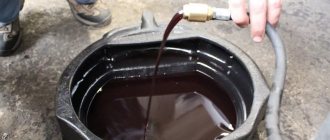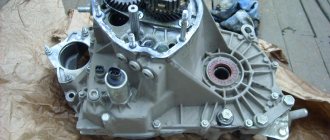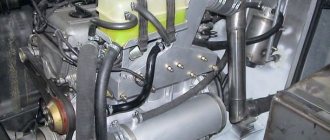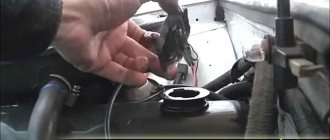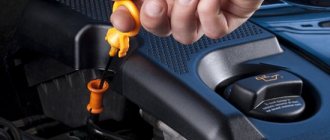Probably, as long as internal combustion engines have existed, there have been debates about whether it is necessary to flush the engine when changing the oil, or whether there is an urgent need for this. In general, the advisability of engine flushing is determined by a number of factors.
Motor oil is a universal liquid that performs two useful functions at once: lowering the engine temperature and lubricating its rubbing parts. By type, oil is divided into synthetic and semi-synthetic, and by viscosity it can be divided into groups W30 and W40. It also makes sense to take into account the manufacturer of the technical fluid so as not to fall for a fake.
With prolonged use, the oil loses its beneficial properties, which leads to overheating of the engine and rapid wear of its rubbing parts. Therefore, the engine oil should be changed on time, or even earlier than scheduled. But depending on what kind of fluid will be replaced, the engine may also need additional flushing.
In what cases should you not flush the engine when changing the oil?
Flushing the engine when changing the oil is not a mandatory procedure, and sometimes it does more harm than good.
Untimely flushing of the internal combustion engine costs the driver not only money, but also time if the procedure is carried out independently. But such manipulation does not affect the quality of work in any way. To improve engine lubrication, it is enough to change the oil ahead of schedule.
But you can ignore it only under the following circumstances:
- The car was purchased new, operated by one owner, mileage less than 50 thousand km;
- The car was purchased from an owner whom you know; you are sure that the previous owner changed the engine oil on time;
- The power unit has been inspected; there is no dirt or thick deposits under the valve cover with a consistency similar to graphite grease; when the engine starts, the low oil pressure light quickly goes out.
- This is not the first time the technical fluid has been replaced, and you know exactly what is currently in the engine (the same applies to cars purchased at a dealership - they are accompanied by a technical certificate where you can see the type and manufacturer of the oil).
- The replacement is made with a technical fluid of the same type, or with a higher quality analogue (high-quality oil has a higher viscosity, due to which it is not afraid of the sediment left by previous technical fluids of poorer quality. The only exception is replacing mineral water with synthetics. With such a difference in quality, flush the engine required).
Disadvantages of flushing the engine when changing lubricant
The oil fluids currently produced already contain everything that the engine needs. Special additives contained in motor oil wash engine parts. So why rinse then?
It must be taken into account that it is impossible to drain all the lubricant from the motor. About ten percent of it will remain in the crankcase, sump, and spare parts. Consequently, fresh oil fluid will mix with the remaining used oil.
Due to the fact that flushing agents contain alkalis that corrode dirt, the characteristics of the new oil will significantly deteriorate when mixed with them. This will have a bad effect on the condition of the engine.
Consequences of dangerous engine flushing
All this also applies to flushing oils, but they are not so alkaline and have less effect on the engine. Is it worth using them? It is better to refuse washing. The exceptions are the situations listed above.
Flushing the engine is definitely not required if the driver bought the car from a dealership and performed maintenance correctly (observed service intervals, filled only high-quality motor oil). You can wash the internal combustion engine if you purchased the car second-hand.
When is it necessary to flush the engine when changing the oil?
Most high-quality motor oils, when circulating through the system, leave a thin protective layer on the rubbing surfaces of the engine. But washing reduces this protection to zero. Therefore, it should be done only as a last resort. For example:
- The car has a mileage of more than 250 thousand km;
- Bought second hand and there is no confidence in the high-quality service of the power unit by the previous owner (especially true if it is a traveling car from a company, a taxi, or has changed many owners);
- The inspection revealed a large amount of dirt deposits inside the engine; the warning light does not go out for a long time or does not go out at all after starting the engine;
- The motor is overheating and the water cooling system is working properly.
If the car was purchased secondhand (the condition of the oil in a used car always raises a lot of doubts, which is why its replacement should be carried out only with preliminary washing.
Moreover, it is advisable to replace technical fluids on a used car immediately after purchase, since there is no guarantee that it has not already become unusable. And receipts provided by the seller for timely maintenance do not provide guarantees to the buyer, since such documents can easily be forged);
If antifreeze gets into the engine oil (a similar phenomenon occurs when low-quality gaskets are installed on the internal combustion engine. In order to completely wash the antifreeze out of the system, it is advisable to flush it at least 2 times).
If the new oil has a distinct quality and viscosity (when replacing synthetics/semi-synthetics with mineral water, or vice versa, when replacing mineral oil with synthetic oil.
If the quality of technical fluid is improved from mineral water to semi-synthetic, then flushing is not necessary. The same applies to changing oil from W30 to W40. Such a replacement will not require flushing. But when switching from W40 to W30, you will have to clean the engine).
It is also advisable to flush the internal combustion engine if the engine using old oil is overheated. Otherwise, there is a risk of contamination of the block with metal shavings.
Manufacturers of flushing oils
Today, every more or less well-known brand in its product line has flushing lubricants or separate compositions for adding to engine oil.
It is not possible to choose the best flushing oil for the reason that these products do not have a single purpose. Some are better at washing off oxides. Others are more effective at removing soot deposits. Still others are aimed at a complex effect.
There are also some restrictions when used in specific car models, which is not a disadvantage of the flushing agent, but is considered a feature of the car.
Therefore, it is impossible to make a sane rating of flushing oils in general, and not in relation to a specific task or car.
Let's take a quick look at some common engine flushing lubricants.
ZIC Flush
Made from high quality synthetics, this flushing oil is well suited for thorough engine cleaning. Has good cleaning properties.
ZIC Flush
Dissolves soot deposits and hardened oxides well. After filling, the engine should run for 15-20 minutes. The manufacturer guarantees a high degree of purification and safety for all types of gasoline and diesel engines.
Flushing oil Lukoil
Product from a domestic manufacturer. There are a number of reviews about it on the Internet. For the most part, they are either neutral (the effect is noticeable, but the car owner expected more) or positive.
No negative effects were found after using this composition. Read more about Lukoil flushing oil here.
TNK Promo (Express or Standard)
Good domestic mineral-based washes from the Tyumen Oil Company. Low price and efficiency allowed this product to occupy its niche in the market. TNK Promo formulations use high-quality imported additive packages.
AGIP Flushing
Inexpensive flushing oil from the largest Italian oil refining company. Acceptable efficiency at a low price.
Agip Flushing Oil
Also today on the market there is a huge number of additives that are used immediately before replacement. The most effective of them, judging by reviews, are Hi-Gear and Liqui Moly.
However, there are also negative reviews about these products. Some car owners have noticed that additives only soften the dirt, but do not completely remove it along with waste.
Assessing the need for engine flushing when changing oil
To assess engine contamination, it is not at all necessary to completely disassemble it; just lift the valve cover or at least shine a flashlight into the oil filler neck and see if there are deposits.
When buying a used car, hardly anyone will allow you to remove the valve cover, so you should consider what is under the oil filler neck. Sellers who are dishonest can wipe the elements of a dirty motor under it to give it a shine.
It should be borne in mind that when changing the oil, with or without flushing, a certain amount of old oil always remains in the engine. This is especially true if the replacement is carried out in a car service using the suction method, and not through the drain hole at the bottom of the engine crankcase.
Even a 1.6-liter engine may have 300-1000 grams of old oil remaining. You can approximately estimate the amount of residue by comparing the volumes of new oil poured and the required value in the manufacturer’s specifications.
How to use flushing oil
A clear answer to the question of how to use flushing oil is indicated directly in the instructions for it . You can usually read it directly on the packaging or in the accompanying documentation. However, in most cases the algorithm is the same and resembles changing the engine oil. In general terms, the process consists of draining the old oil, pouring flushing lubricant in its place, running the engine on it for 10-20 minutes and draining the resulting liquid.
Ideally, after draining the flushing oil, you need to use a special compressor or vacuum pump, which can be used to remove residual oil from the crankcase (usually about 200...300 grams remain after draining).
Conclusion
Flushing oil is a very useful tool that can be used to extend the life of both the engine itself and the engine oil . The flushing process is especially recommended when purchasing an old car, switching to a new type of oil, after significant loads on the engine, or when it is heavily clogged. As for the choice of one oil or another, their characteristics are approximately the same.
Therefore, base your choice on the ratio of price, quality and its availability on retail shelves. You should not neglect reviews of various brands, because sometimes they are not always suitable specifically for your case. And try to make purchases in trusted stores so as not to run into counterfeit goods.
Does flushing the internal combustion engine depend on the type and type of oil being poured?
There is an opinion that it is necessary to flush the engine when changing the oil if, for example, oil from another manufacturer is filled, semi-synthetic or mineral oil is replaced with synthetics. In any case, washing is not worth doing.
This process is carried out only to clean the engine of internal deposits. Any cleaning products have a fairly aggressive detergent composition. After incomplete draining, they mix with new oil and can harm the engine.
Also, some drivers believe that it is worth doing a flush when changing oil manufacturer. This is wrong. There is no guarantee that when buying oil from the same manufacturer, you will receive a product with the same composition.
Firstly, the manufacturer himself can change the recipe, and secondly, there is always a risk of buying a fake. The base oils mix well with each other. The differences are in the additives, but their mass is small and they do not have a significant effect when mixed.
When replacing, you should pay attention to the condition of the drained oil. If there are a lot of thick inclusions or lumps, then it is better to flush the engine when changing the oil, or next time replace it after 3-5 thousand km along with the oil filter.
Repeated replacement with a shorter mileage interval is preferable. Flushing compounds can quickly wash away all deposits, but their circulation through the lubrication system can cause harm to the internal combustion engine system.
Total.
Traditional conclusions of the article: Under normal operating conditions and the engine is slightly dirty, flushing the oil system is not necessary; a good engine oil can handle the dirt, with replacement according to the regulations (it’s better still no more than 12 thousand km). For difficult cases, there are several ways to wash off dirt. The most radical is disassembling the engine and rinsing components and parts in diesel fuel. Long/expensive, but effective and safe (if there are no unnecessary parts left after assembly :)) Next, a very popular, but unsafe option with 5-minute flushes of the oil system, it cleans, but creates the danger of clogging the oil intake grid due to the lack of a sufficient amount of dispersants at the moment and after flushing, which can lead to oil starvation and engine damage. Options with dimexide, white spirit and other “folk” remedies, even if they wash, also do not provide the volume of oil with dispersants, so the danger is equal to five minutes. Mild engine flushes are much more acceptable, since along with detergents they also contain a certain amount of dispersants that “lock” dirt in small particles inside the oil volume and prevent them from sticking together into large pieces, sealing the same oil intake mesh. Of course, provided that there is not much more dirt there than the available amount of additive can hold. And finally, the most optimal option for flushing if the engine is very dirty. It consists of cleaning the engine in several stages, at each of which a supply of fresh dispersant additive must be provided in the oil volume. This is standard oil, soft flushing, expensive flushing oils, diesel oils with a high alkaline number. A combination of these methods will give an excellent result and will be safe for the engine.
Types of flushes
The procedure for cleaning the engine when changing the oil directly depends on the type of flushing fluid used:
Special flushing oil
This is a technical fluid with a mineral composition, which includes many active additives. Unlike the “five-minute”, it does not wash off the protective layer from the rubbing parts, having a milder effect on the internal combustion engine. But you also need to use it no longer than 5-10 minutes, at idle speed
Manufacturers recommend using it before adding new oil. You need to drive the flushing oil in a gentle mode (as during break-in - low load, speed no higher than 3000 per minute) for 100-200 km, and then fill in new oil and change the filter.
Regular motor oil
A technical fluid with reduced quality or viscosity is used. You can flush the engine with the same oil that is planned to replace the previous fluid. To do this, the engine must be operated for 1-2 days and the lubricant must be replaced again.
Chemical compositions of the “five-minute”
These are organic solvents that resemble ordinary water in consistency. To clean the engine, such liquid must be poured into the engine, instead of old oil, and let it run for 5-10 minutes in idle mode. Then the oil is changed to a new one, with the oil filter replaced.
It is strictly forbidden to operate the engine for five minutes, as there is a chance of heating the rubbing surfaces, followed by a wedge of the piston group.
The compositions have an aggressive composition; when mixed with old oil, unwanted chemical reactions can occur. The problem is aggravated by incomplete removal of the composition when adding new oil.

